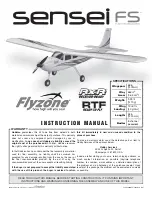
11
❏
10. Connect the aileron servo wires to the Y-harness from
the receiver. Secure the wing to the fuselage with two 6x25mm
nylon bolts.
❏
11. Move the aileron stick to the right. The right aileron will
move up and the left aileron will move down.
If any of the control surfaces move in the wrong direction, use
the servo reversing switches shown in Step 2 to change the
direction. If using another brand transmitter, follow the directions
in your radio manual for reversing the servo directions.
Check the Control Throws
One major factor that determines how an airplane handles
in the air is the control surface throw, or how far each control
surface (aileron, elevator and rudder) moves up and down or
left and right. If the throw is too much, the plane will respond
too quickly. If the throw is too little, the plane will respond too
slowly. The control throws in the Sensei have already been
determined by where the pushrods are connected to the servo
arms and the control surfaces and by how far the servo arms
rotate. But, if you are using a radio control system different
than the Tactic TTX610, the servo arms could rotate more or
less than anticipated, changing the throws. Therefore, it’s a
good idea to double-check the throws just to make sure they
are acceptable. Follow the procedure below to make sure the
control throws are properly set. Be sure that both switches on
the front of the transmitter are in the "up" position.
Measure the elevator throw fi rst:
❏
1. Still without the propeller mounted on the motor, switch on
your transmitter and connect the motor battery. Check that the
dual rate (D/R) switch is in the up position (high rate). With the
switch in the up position the servo arm travel is 100%. This rate
allows the plane to be more responsive in certain maneuvers.
With the switch in the down position (low rate), the servo arm
travel is 60% of full travel. This rate allows for smooth basic
fl ying and is good for the beginner who is just learning to fl y.
❏
2. Place a ruler next to the trailing edge of the elevator at
the widest part (from front-to-back).






































